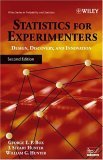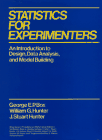Statistics for experimenters
williamghunter.net > Statistics for experimenters

|
Statistics for Experimenters - Second EditionOrder your copy of Statistics for Experimenters: Design, Innovation, and Discovery, 2nd Edition by George Box, Stuart Hunter and William G. Hunter, 2005. Rewritten and updated by George Box and Stu Hunter (Bill Hunter died in 1986), this new edition of Statistics for Experimenters adopts the same approaches as the landmark First Edition by teaching with examples, readily understood graphics, and the appropriate use of computers. |
From the publisher: Catalyzing innovation, problem solving, and discovery, the Second Edition provides experimenters with the scientific and statistical tools needed to maximize the knowledge gained from research data, illustrating how these tools may best be utilized during all stages of the investigative process. The authors’ practical approach starts with a problem that needs to be solved and then examines the appropriate statistical methods of design and analysis.
Complete with applications covering the physical, engineering, biological, and social sciences, Statistics for Experimenters is designed for individuals who must use statistical approaches to conduct an experiment, but do not necessarily have formal training in statistics. Experimenters need only a basic understanding of mathematics to master all the statistical methods presented. This text is an essential reference for all researchers and is a highly recommended course book for undergraduate and graduate students.
Data files for use with Statistics for Experimenters, 2nd Edition
Google Scholar citations for Statistics for Experimenters
Details on the classic first edition

|
Statistics for Experimenters, 1st Edition, 1978 by George Box, Stuart Hunter and William G. Hunter. A classic text for experimenters in scientific and business circles. To the Life and Legacy of William Hunter site. |
Recommendations of Statistics for Experimenters
-
Another genius named R.A. Fisher used this cube to create what is now known as the designed experiment. Fisher's colleagues and friends in the United States, Walter Shewhart and W. Edwards Deming, were inspired by the economy of his ideas. Fisher's model led to productivity breakthroughs in agriculture, medicine, bio-statistics, chemistry, and all other industries. Fisher's student, George Box, helped make Fisher's work accessible to undergraduate engineering students.
The Box, Hunter, and Hunter textbook Statistics for Experimenters, A Introduction to Design, Data Analysis, and Model Building is the classic work that we distilled into a simplified model that can be used everyday on the job.
Daniel Sloan www.danielsloan.com
- Newsletter ASA Statistical Education Section. Recommended gift for undergrad statistics student: 1) Statistics for Experimenters or The History of Statistics.
- Still the "Bible" of practical design of experiments
More than twenty years after its publication, this seminal work is still the undisputable "Bible" for users of statistical experimental design. The practical insights sprinkled throughout this book are invaluable especially to non-mathematical statisticians. This book will never be out-of-date!
Professor T.N.Goh from National University of Singapore, August 7, 1999
- Applying Statistics to Industry has never been easier
Application of statistics in an industrial setting is often perceived as being difficult and time-consuming. This book clearly demonstrates that the use of experimental design not only enables a wider range of conclusions to be made, but the use of designs can minimizes the time, effort and cost required to obtain the results. George Box presents the theory clearly with many real-life industrial examples. It is the application of the theories to the examples which thoroughly convince the reader that the combination of a knowledge in ones area of expertise and the application of statistics can lead to extraordinarily promising results.
Dawn Sadlowski
- Excellent Book for the Statistically Challenged!! Not being a statistician but needing to understand Design of Experiments, I found this book to be extremely valuable. Box walks you thru the basic concepts through prediction and understanding of complex response surfaces. After taking it out of the library twice, I decided it was important to get my own copy. I now recommend it in every class I teach on optimization using finite element methods. DoE adds a whole new dimension to product performance simulation.
Vince Adams, author of Building Better Products With Finite Element Analysis - WyzeTek, Inc.
"The book that is considered the 'Bible' of DOE" - New England Biometrics
Six Sigma Forum Magazine interviewed (May 2002) five leading teachers of Six Sigma and asked the following question: What literature on the topic of Six Sigma do you find most useful. 3 of 5 recommended Statistics for Experimenters, including Tim Clapp, "We recommend this book for students who want to learn more about experimental design. Many of the examples we teach in class are based on this book or on notes from a recent series of lectures Hunter gave here last year."
Citations of Statisitics for Experimenters, from CiteSeer.
Citation of Statistics for Experimenters in other books, from Amazon.com.
"This is a book that every scientist and engineer in industry should read and own." Math Options web site quote.
The following links no longer work
To avoid this problem web site owners may take steps to avoid linkrot.
- Response Surface Methods for Analysis and Optimization of Protein Crystal Growth, Workshop References - Especially Recommended: Statistics for Experimenters and The Cartoon Guide to Statistics.
- Some time ago, Dave Duewer solicited the list for favorite chemometric references. Statistics for Experiments was sited by 11 people (number 1), 2 books sited 6 times, 1 five times, 1 four times...
- Good Decision Ltd. 5 books that we can recommend . On Statistics for Experimenters they state: "Still unsurpassed for scope, substance, insight. Widely known for being helpful with fractional factorial designs, but it also has good stuff on randomisation, inference, contingency tables, regression, and time series analysis."
- Six Sigma Black Belt Training - Juran Institute. Included Materials: Juran Institute’s Six Sigma Black Belt Workshop Participant Binder, Juran’s Quality Handbook - Fifth Edition, Statistics for Experimenters ("The leading textbook for design of experiments"), MINITAB (version 12).
